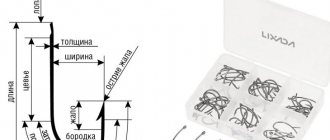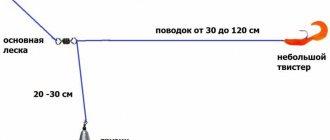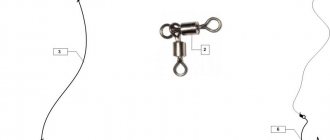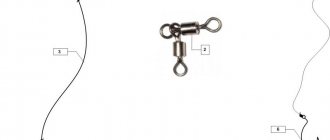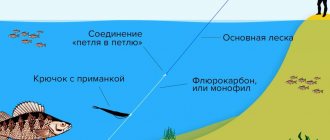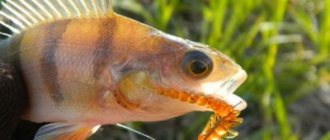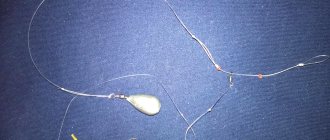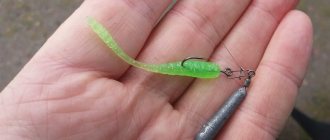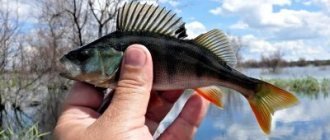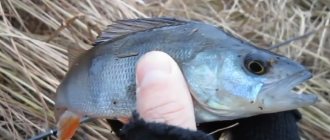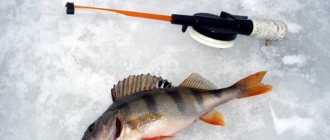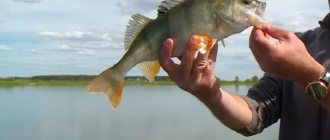Buy quality products at affordable prices in the best fishing online stores
. Give gifts to yourself and your loved ones!
we are in social networks
— subscribe to us on Facebook, Youtube, VKontakte and Instagram. Stay up to date with the latest site news.
Perch is a valuable predatory fish. Its taste qualities allow you to prepare delicious fish soup. Perch is caught mainly with spinning rods. Even novice spinning anglers can successfully catch perch. The main thing is to find places where this predator is concentrated.
As a rule, specimens weighing up to 500 grams are caught. Catching kilogram perch is just as lucky as catching kilogram crucian carp. Therefore, ultralight, light and medium class rods are used for perch.
When fishing in shallow areas, it is best to use ultralight dough up to 8 grams. This rod works well at depths from 0.5 to 1.5 meters. At depths of 1.5 to 3 meters, it is better to use a light rod with a weight of 3 to 15 grams. These rods can cover both shallow and deeper areas.
Medium rods allow you to work with bait weights from 5 to 40 grams. These are the most versatile fishing rods that allow you to use the entire arsenal of baits and serve them at different depths. If the perch bite is good or very good, then medium is the most ideal option.
Reels are used with spool capacity from 1000 to 3500 with front drag.
Ultralight spinning rod for perch
Ultralight rods for perch fishing should have a test weight of 1 to 8 grams and a length of 1.8-2.1 meters. With its help, you can easily cast light spinners weighing up to 2 grams, as well as perch jig baits weighing up to 9 grams. Ultralight is used mainly for fishing from boats, since the minimum length makes it easy to work in a small boat. The structure of this spinning rod is of a semi-parabolic type. Why this type? The fact is that with its help you can make long casts with light equipment, and not lose sensitivity during retrieves.
The ultralight is equipped with a spinning reel with a spool capacity of 1000 to 1500. The weight of the reel should be minimal. For this reason, many of the reel elements are plastic. It's better to have a spare spool. On one, wind a braided line with a diameter of 0.08 mm, and on the second, also a braided line, but with a diameter of 0.1 mm. If the fishing spot is clean enough, with a minimum amount of snags, shells and debris, then first set up a spool with a thinner line. In more contaminated areas, it is advisable to fish with a thicker fence.
The most popular lures that are used when fishing with ultralight are spinners with sizes 0 and 00 numbers. With their help, it is good to carry out wiring near the surface of a reservoir. Another popular bait is the popper. With its help it is convenient to fish on the surface of a reservoir.
If the perch is active in the water column, in the middle layers, then it is better to use spoons and small wobblers up to 5 cm long. In the fall, jig baits of minimal sizes are placed on an ultralight rod. Often, a twister equipped with a small ball weight is used to catch perch. The best places for ultralight fishing are coastal areas surrounded by vegetation, small snags and places near bridges and objects located at the bottom.
As you can see, the equipment of an ultralight spinning rod involves the thinnest and most delicate baits and fishing line, as well as a miniature reel.
What to catch perch with
Lures for catching perch come in a wide variety, but in order to catch a couple of good trophies, you should choose only the right products. Among the most modernized and very popular fishing inventions are:
- A tailspinner is a very popular tool that is equipped with a weighting element and a rotating petal behind the hook.
- Twister is an effective soft bait made of silicone or soft plastic. And although more and more new solutions appear on sale, twisters are still in great demand and have practically no analogues.
- Wobbler - all spinners love to fish with a wobbler, not only professional ones, but also beginners. This solid bait perfectly imitates the behavior of live, wounded prey. On sale you can find three types of wobblers, which differ from each other in terms of density: DD - a sinking model, which greatly facilitates determining the depth and is considered indispensable for finding the largest specimens, F - a good floating version, made of wood and imitating a sick fish, SP - neutrally buoyant. Such models are effective when performing slow retrieves when you need to interest lazy fish.
- Spinner is a universal and simplest bait that exhibits excellent performance at almost any time of the year. On sale you can find a traditional oscillating spring and a fairly productive spinner.
As for spoons, they create an excellent imitation of the behavior of real fish, therefore they are considered indispensable for catching predators. Turntables equipped with a rotating blade are an acoustic bait that is used not only by pike and perch, but also by “white” fish. Also on the market you can often find the so-called fly bait, which demonstrates very fast rotation in the water.
Light spinning rod for perch
Fishing with a light rod is carried out both from the shore and from a boat. Basically, the length of the spinning rod is 2.1-2.4 meters. Parabolic type rods are mainly used. In some cases, fishing rods 1.8 meters long are used. Having light rods of different lengths, you can catch perch in both wide and narrow sections of rivers. The test for these rods is 2-20 grams.
The reel for light spinning is selected according to the weight and length of the rod. In terms of volume and weight, it is slightly larger than an ultralight reel. The spool size is 1500-2000. We also wrap braided wire around it, as it better transmits even light pokes and pulls of the perch. The thickness of the fence is 0.1 – 0.12 mm. The selection method is the same as for ultralight.
The most popular bait for perch fishing is a spinner. It is better to have a set of spinners of different sizes and colors and catch perch with them. Such baits work better in shallow areas with moderate amounts of vegetation. In these places, the greatest results are achieved by bottom and surface wiring of a leash with a light rod. When fishing with spinners, the retrieve is slow and fast.
Oscillating spoons are less popular for fishing. When using such lures, it is better to use a thin metal leader. Since pike are also found in perch habitats, such a leash will preserve the lure during serious attacks by this predator. A woolen twister is sometimes placed just above the spinner. In this way, two different baits are supplied, one of which will definitely seduce the striped one.
Another popular bait for bass fishing is cicadas. In water they move along interesting trajectories. Active perch like such baits and actively take them. Poppers are also in the bass' area of interest. When fishing near the surface and in the middle layers, schools of fish attack the bait.
The size of all baits is from 4 to 7 cm. Depending on the casting distance and fishing depth, they are loaded with Cheburashkas and lead balls. The weight of the entire bait should not exceed 20 grams.
Lures for fishing
This predator can be caught equally well on both rotating and oscillating spoons.
As for baits, there can be no clear recommendation or advice. It won’t be difficult to catch a “striper” using wobblers, proppers and other artificial baits.
The main rule of perch fishing is not to use too bulky or massive baits. The average weight of a spinner or wobbler is 5 grams. Another important feature that must be present in artificial lures for perch is shine.
Spinners, regardless of design, must have this quality. Wobblers that imitate whitebait should also have a reflective coating in attractive colors. Lures painted yellow and silver are most attractive to this predator.
Medium class spinning rod for perch
When catching trophy specimens weighing over 1 kg. It is better to use a medium class spinning rod. The test weight of such rods ranges from 15 to 40 grams. They are distinguished by their slow action and long range. Their length varies between 2.7 - 3 meters. These fishing rods are used to fish on wide rivers in areas with depths of more than 3 meters.
Since fishing is carried out at depth, often in the bottom layer, wobblers, twisters and spoons loaded with weights are used. The wiring is average and slow.
The rings on these rods are larger. The reel on mediums is used from 2500 to 3500. A wattle with a diameter of 0.18 or a fishing line with a diameter of 0.25 mm is wound on it.
Selecting a spinning rod
for perch fishing , but the most popular is the spinning rod. Catching perch with a spinning rod from the shore is a constant environment, many unpredictable situations, a fast bite, a very difficult fight with a ferocious predator, and also the opportunity to fish for a real trophy. Looks tempting, doesn't it? But the success of the upcoming fishing is closely related to the choice of suitable gear, so if you have to choose a spinning rod, do not ignore a number of important points.
Selecting gear consists of several key steps:
- Finding a fishing rod.
- Selection of fishing line.
- Buying a reel.
It is the rod that is the main part of such a trinity, so its choice should be treated with increased attention. The most important characteristic of the form is its structure. The indicator indicates the ability to resist bending under a certain load, and as the experience of many spinners says, for perch fishing it is advisable to choose medium and slow action. This will significantly reduce the number of escapes that occur when the delicate lips of a perch are torn in the last seconds of fishing.
The next important indicator is the test. The markings indicated on the form are displayed in grams, demonstrating the spread of equipment weights, which will not be able to overload the rod when casting. To select a test, you should take into account the type of bait you prefer, but the universal number is 15 g.
More information about lures for catching perch
Let's take a closer look at in what cases it is better to use certain baits when spinning perch fishing.
Silicone
Poppers, twisters and vibrating tails are best used in cases where we have decided on the fishing location. When we find schools of perch using an echo sounder or from experience, we know that there are a lot of them here. In this case, we install a popper or twister and begin to perform slow wiring. It is better to do this from a boat, since there is not always access to promising areas on the shore. From a boat we can fish 5-6 points non-stop. It doesn’t take in one, in the second, we quickly move to the third point and successfully catch a perch.
If the current is small, the boat can be released and fished “in motion.” For active fish, they usually use a vibrating tail or a silicone fish. The bait is supplied to the bottom or surface layer, depending on the conditions and time of fishing, and where the perch is located on that particular day.
It is better to tempt inactive perch with twisters. When fishing with twisters, slow retrieval is done. Often, thanks to twisters, fishing can be saved. There are no general recommendations for colors. It is extremely important to have a perch set of twisters in case of a capricious bite. Often you have to go through all the baits to find one that “works” on that particular day.
Wobblers
When catching perch, small wobblers with a length of 4 to 10 cm are often used. As a rule, a school of perch hunts several fish, driving them to the surface of the water. Sometimes he hunts near bushes and snags, as if waiting for prey. If you give him a floating wobbler, it can interest the predator and provoke him to attack.
It is important to know which fry live in a particular body of water. What is their size and color? The wobbler should match the color, size and shape of the fry as much as possible. The larger the fry in the reservoir, the more active the perch, the easier it is to catch it. As soon as the size of the fry reaches 3-4 cm, it immediately becomes desirable to a predator.
Rotating spoons
The most popular lures for catching perch among many anglers are spinners. The most popular weight is from 3 to 7 grams. The advantage of spinners is that they can be used for fishing both from the shore and from boats. Bloodworms, maggots and worms are sometimes hung on tees to attract inactive individuals. Often such an additional attachment can give amazing results. The fisherman makes a leisurely retrieve, and the perch attacks the bait. If you get on a normal flock, then in an hour or two you can take up to 4 kg. perches.
The color of the spinners is selected depending on the lighting. In sunny weather, duller white spoons work better, but in cloudy weather, on the contrary, it is better to use shiny ones with a golden tint.
Spinner for vertical fishing
When fishing from a pier and boat, the vertical trolling method is often used. Such spoons weigh several tens of grams. They are placed on medium rods. They are also called jigs. Fishing is carried out as follows: the bait is placed on the bottom and raised a few centimeters with small strokes.
These lures are sold in two colors: silver and gold. Some spinners have a grayish tint. Sometimes, if the spoon loses its brightness, it is rubbed until it looks shiny, and it becomes catchy again.
Summer fishing
In the summer, it can be a float rod, donka or spinning rod. On floodplain channels and rivers with thickets of water lilies, they are caught using tackle with a float or a fishing rod with a summer side nod. In rivers, lakes and reservoirs with fishing rods, donks, spinning rods, sometimes from a boat in the winter using a plumb line.
Fishing rods and donks
Most often, float fishing rods are equipped with one hook, nod, jig or reelless, but donkeys are most rationally equipped with two or three hooks.
Worm
They either buy the worm or dig it themselves. You can put a worm on a hook in different ways, most often they pierce the hook’s sting in the front part, pass it through the whole body and leave the sting inside, the remaining part continues to hang, it moves under the water, attracting fish. The method is suitable for float and nod gear.
Malek
The fry are caught with nets, spiders, jars with a hole in a plastic lid, gauze in a wade and other methods. It is attached depending on its size; a small one is put on either like a worm across the whole body, or in a bunch of several pieces through the eyes. A large one is most often dressed through the eyes, this way it remains alive longer, attracting a predator with its movements.
Spinning
For spinning fishing, there are a lot of different baits, gear and presentation methods. Perch is caught on spoons and spinners, all kinds of wobblers and their varieties; modern silicone baits perform well.
To catch, you can use different spinning rods and reels. Thrill-seekers use very light baits and spinning rods of the ultra or super ultra light class.
Mounting methods
- Lures are tied directly to the fishing line, and the load is about thirty centimeters above the bait.
- Put the heads on the jig.
- Tied to diverting leashes.
- The drop shot method is used.
Posting baits
The first method is used with very small and light baits for long-distance casting. A sinker is attached to the fishing line; a bell is best suited; it is easy to install and can be adjusted by moving the distance to the spoon along the fishing line.
The second method uses different jig heads and Cheburashkas with a combination of doubles or offset hooks with silicone or foam baits.
The third method is very good when the predator is inactive. Unlike the drop shot rig, here a leash of thirty to one and a half meters with a hook is tied to the main line fifteen to forty centimeters from the load, which can be a jig head with a silicone fish or a Cheburashka. A silicone or other bait that imitates a fish is placed on the hook. Instead of a hook with a fish, a wobbler or a rotating spoon can be attached.
Wiring is carried out using a classic jig. Cast, fall to the bottom, three turns of the reel, fall to the bottom, and so on, until the bite. Wiring can be combined in other ways.
A drop shot differs from a rig with a retractable hook attachment. Drop shot hook, tied directly to the fishing line, at a distance of thirty-five centimeters above the load tied at the end of the fishing line. The most popular nodes are Palamar and Gardner.
Wiring a drop shot differs from a jig in that after lowering the load to the bottom after casting, make 3-4 turns with the reel and wait for the load to hit the bottom. Then, slightly twitching the fishing line, imitate a wounded fish with silicone bait. Shot equipment has proven itself well not only for perch, but also for pike perch. Fishing with this type of gear is best done from a boat.
vertical fishing
It is preferable to catch perch vertically from a boat. For this method, either a fishing rod for winter trolling is used, or you can make tackle from a regular short spinning rod.
If you don’t have a boat, you can do it from the shore, in which case you will need a spinning rod or fishing rod, preferably fast or medium action, at least 2.7 meters long.
Fishing in a vertical line is suitable for snags; jig heads with an attachment that imitates a fish work better here; jig allows you to fish in difficult places and avoid frequent snags. Also, they fish vertically at depths of over 3 meters, so that the shadow and noise in the boat do not scare off the striped predator. In addition to jig, spoons and balancers are used as bait. There are other methods and gear for catching perch in the summer. I told you about the most popular ones.
How to attach baits?
When fishing with silicone fish, twisters and soft wobblers, jig weights are used, which will ensure long casts. The hook should come out halfway from the body of the bait, and the tail should move freely, without connection with the hook. In this case, the bait behaves believably, provoking an attack from the greedy perch. The weight is attached to the main line or on a leash in front of the bait. This results in a Texas rig.
If a plastic or rubber worm is used, then place the sinker on a retractable leash, the so-called paternoster. In this case, a triple carabiner is tied, and then a sinker is attached to a fishing line 20 -30 cm long. The bait is tied to the carabiner.
In the second option, a three-sided carabiner is tied to the main fishing line, then a paternoster sinker is attached to a piece of fishing line 10-20 cm long. In addition, a mounted wobbler is tied to the carbine. The leash length varies from 25 to 75 cm.
When fishing on a littered bottom, or on a shell, or when fishing for large perch, be sure to use a fluorocarbon or metal leader. Fluorocarbon is better, as it is invisible in the water. Its length is up to 75 cm. It is attached to the main fishing line through a swivel. At the other end there is a carabiner for attaching baits.
Perch fishing equipment
In this article we will look at “peaceful” equipment for catching perch.
Installation of a fishing rod for perch fishing
To catch perch, a fly rod or Bolognese rod with a length of 4 to 6 meters and a weight of 5 to 20 grams is used. If the perch stays near the shore, then it is better to fish with a swing, since such a rod can be used to attach the finest equipment: a fishing line with a diameter of 0.12 mm and a float with a carrying capacity of up to 1 gram. The reel and rings on the lap dog will quickly render such a thin fishing line unusable.
If fishing is carried out in a fast current, then it is better to use a 5-meter lapdog with a spinning reel. The size of the spool on the reel is from 1000 to 2000. The diameter of the fishing line is from 0.16 to 0.2 mm. The float is installed with two attachment points.
It is loaded with one pellet and a subplot with several more pellets.
When fishing with thin tackle there is no particular need for a leash. If the bottom is clean and there are no snags, then the leash is not installed. The fact is that he can twist the line if it is soft. This increases the likelihood of overlaps and deformations of the main line. In addition, using a leash involves using a thicker fishing line. If you have to fish with a leash, then its thickness does not exceed 0.1 mm and length 15 cm.
The hook for catching perch on a fishing rod is No. 18-20 according to the international classification. If fishing is done with bloodworms, then hooks with the thinnest wire, special “bloodworm” hooks, are used. If you fish with a worm, then use hooks with a long shank with small notches for better fixation of the bait. It is important to have a sharpener for straightening hooks that have become dull on the rocky bottom. Some anglers claim that perches bite better on hooks of bronze and golden shades.
Preparing a donk for perch fishing
To catch perch on the bottom from the shore, use a spinning rod or a folding rod up to 3.3 meters long and with a weight of up to 80 grams. A small spinning reel with a spool capacity of 2500 to 3000 is installed on the rod. A fishing line with a diameter of 0.25 mm is wound on it. A strong carabiner is tied to the end of the fishing line, to which the equipment is attached. It is a piece of fishing line 1.5 meters long. A sinker weighing 40-60 grams is tied to the end of the fishing line, and two or three leashes with hooks No. 8-10 are tied above. The length of the leashes is 10 cm, their diameter is 0.2 mm. They are located at the same distance from each other. Leashes can be tied using these methods, or through small swivels.
Animal baits are attached to the hooks: worms, fry, leeches. When fishing from the shore, three or four donks are used simultaneously, depending on the activity of the fish. When the bite is sluggish and ineffective, the equipment is pulled a little towards the shore, thus provoking the perch to bite. The jerks are sharp and short. After each reel, the perch is given a chance to prove itself - to take the bait. With this type of fishing, it is better to use a sliding sinker. In this case, it runs between two stoppers. A 40 cm long leash with a hook is attached behind the weight.
Instead of a sinker, you can also use a method feeder, into which you stuff porridge with pieces of worms, maggots and bloodworms. The baits in this case are traditional: maggots, earthworms and bloodworms.
The same equipment is used when fishing from a boat. Only instead of a long rod, a side fishing rod up to 70 cm long is used. Instead of a spinning reel, they use a regular one, as for winter fishing. A fishing line 40 m long and 0.25 mm in diameter is wound onto a reel. A heavy jig with hook No. 7 is tied to the end of the fishing line. It is also used as a sinker
Above this jig, another jig is tied on a leash 7 cm long with the same hook, but with a smaller load. The diameter of the leash is 0.2 mm. If the water is cloudy in the fishing area, then use dim jigs. If the bottom is clean and the water is clear, then shiny jigs in silver and golden shades work better. Worms, leeches, pieces of fish, eyes of fry, and crayfish meat are hung on hooks. Perch is caught on donkeys at a depth of 3 to 5 meters. The bait is periodically moved and played with, as in winter fishing.
The best tackle and bait for perch
Perch is found in all fresh water bodies; individual individuals of this fish species can reach significant sizes. Along with greater weight, they also acquire a hump on their back, which is why they are called humpbacks.
Perch is a predatory and voracious fish that greedily grabs bait, preferring its natural version. It bites well on tadpoles, worms, jigs, and larvae. He also does not refuse artificial baits, which is often used by experienced fishermen.
This fish can be caught throughout the year. The activity of perch decreases somewhat in the spring during the spawning period. It does not show interest in the surrounding world even in severe winter frosts, but during the thaw period the perch begins an energetic search for food.
All these behavioral features of perch are, of course, known to experienced fishermen. For successful fishing at different times of the year, you will need different gear and appropriate fishing tactics.
Perch can be successfully caught with all types of fishing gear that currently exist. This list includes a traditional fishing rod with a float, donks of various types, girders, and spinning rods.
Read: Catching perch with ultralight
As the weather warms up, schools of fish move to shallow water. It is in these places that perch fishing is organized in the spring. After spawning, the fish becomes especially voracious, because it needs to replenish lost strength. During this period, perch willingly swallows any bait, which ensures a good catch even for a novice angler.
The hot summer sun forces fish to move to deeper and cooler places, and this is where you should look for them. Moreover, the fish will be especially active in the evening and morning dawn, and the heat of the day will make it lazy and indifferent. Wire fishing is considered the most effective in summer, and this tactic is used by most fishermen.
In autumn, the fish become active again and can be caught throughout the daylight hours. The best results during this period will be achieved by using bottom gear in the form of an elastic band and several leashes, as well as a fishing rod with additional equipment.
Winter fishing for perch is possible during the thaw period, as well as at the beginning or end of winter. It is carried out with mandatory complementary feeding. A self-expanding table filled with food of animal origin, flavored with dry blood, must be lowered into the hole. A hungry perch will definitely come to its delicious smell. Well, then it’s a matter of technology and equipment. In this capacity, fishermen most often use winter lures.
